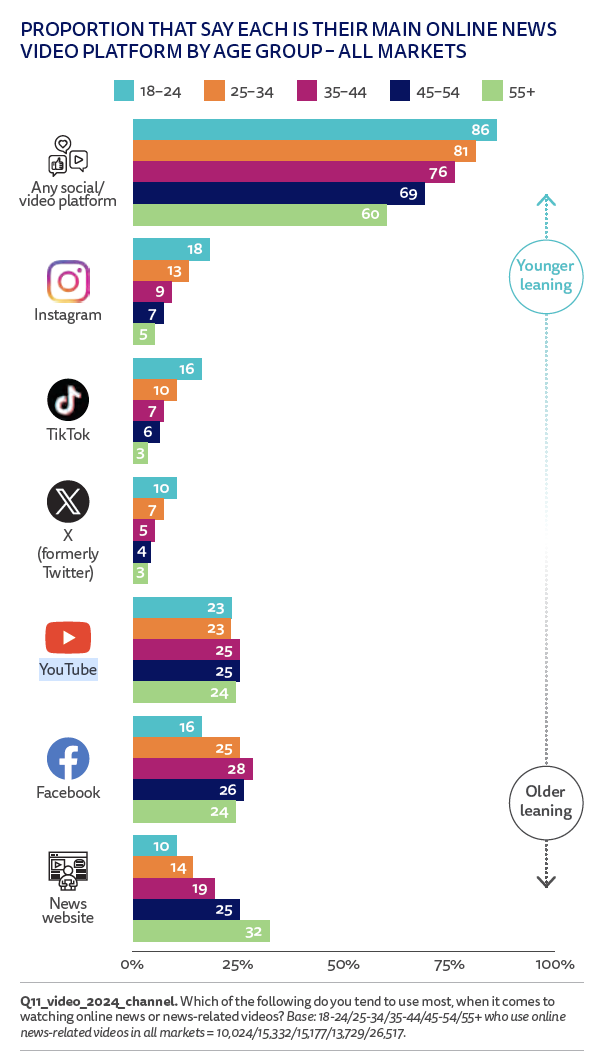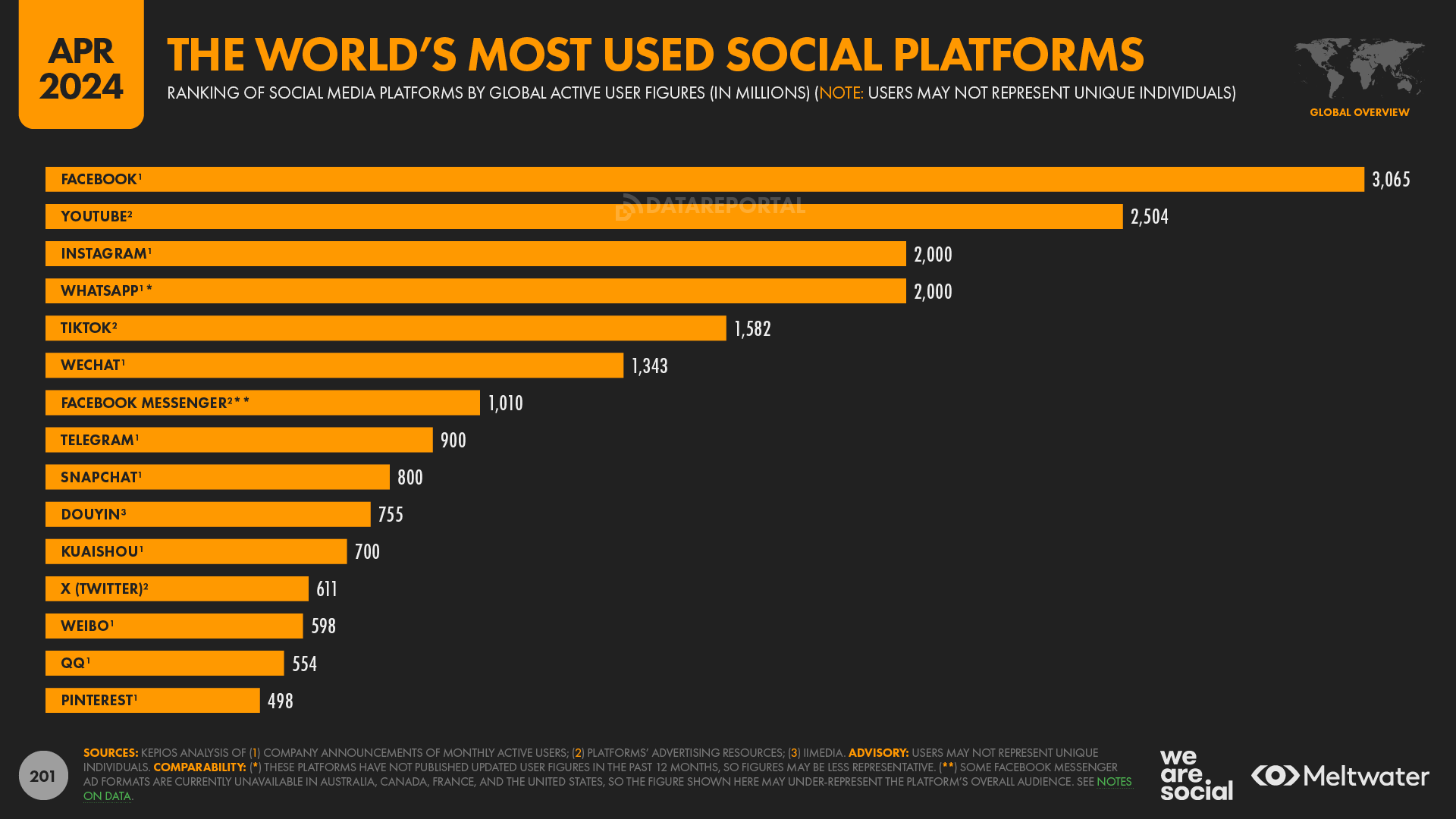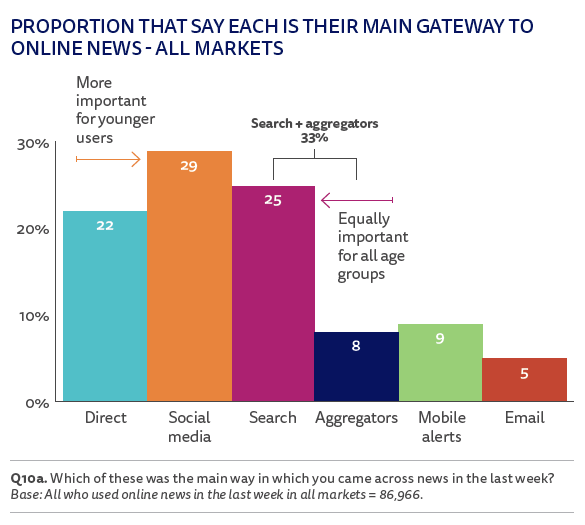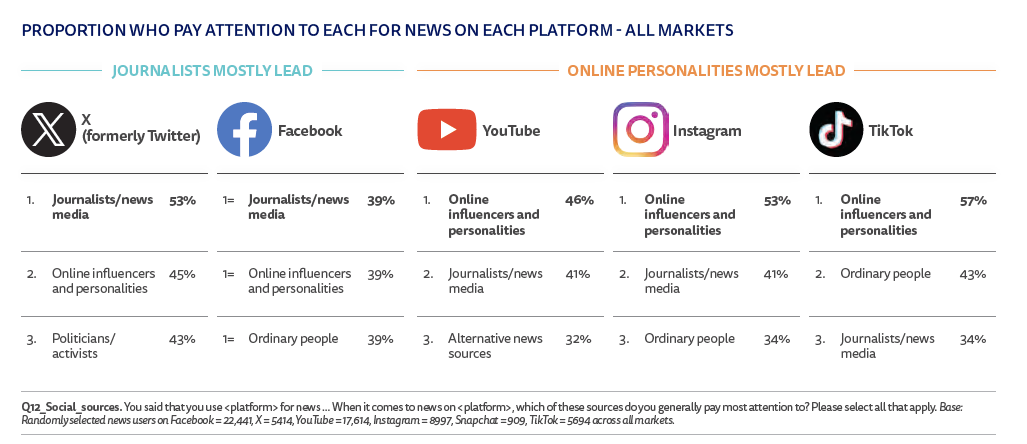Published by the Reuters Institute for the Study of Journalism, the annual Digital News Report is required reading for anyone interested in the health of journalism and news media. Covering 47 global markets, the latest report clocks in at 168 pages and features insights gleaned from nearly 95,000 news consumers.
Continuing trends from previous years, some of the key issues to emerge include: the rise of video news and video platforms (with TikTok notably continuing to gain ground with younger audiences), rising concerns about misinformation (especially on TikTok and X), ongoing issues of news avoidance and news fatigue, as well as stagnating subscription levels in many major markets such as the U.S. and U.K.
Many of these topics have been explored elsewhere, often in a flurry of hot takes accompanying the study’s initial release. Taking a step back from this, the report also provides valuable data and case studies that can be used to inform newsroom strategies for many of the problems plaguing the industry.
In that vein, here are three actionable areas that every newsroom should explore.
(1) You need a YouTube strategy (if you don’t already have one)
I have long argued that newsrooms underestimate the power and importance of YouTube. For too many outlets, their presence on the platform is an under-resourced afterthought. That’s a mistake.
As the report authors note, “YouTube is used for news by almost a third (31%) of our global sample each week.” Moreover, unlike other more visually oriented platforms – like TikTok and Instagram which tend to be used by younger audiences – YouTube’s appeal is remarkably consistent across all age groups.
Within that, and perhaps surprisingly for many newsrooms, “YouTube is also the top destination for under 25s, though TikTok and Instagram are not far behind.”
Most newsrooms pay a lot more attention to these newer platforms than YouTube, the granddaddy of the video-first social networks. This finding may encourage them to rethink that approach.

The continued evolution of the YouTube platform also offers opportunities for newsrooms.
Perhaps the most obvious manifestation of this can be seen in the popularity of video podcasts, and podcast consumption on the network.
Alongside this, there are also opportunities for other content to reach major audiences.
In the States, nearly half (45%) of all YouTube viewership takes place on connected/smart TVs. As eMarketer has noted, that’s up from under 30% in 2020.
This has created opportunities for both short and long-form content to flourish. The platform is home to everything from short-form video (e.g. YouTube Shorts) to longer content such as documentaries or extended interviews like Vogue’s 73 Questions format and Hollywood Reporter’s hour-long roundtables with leading actors and directors. (I’ve always thought the latter would work well as a podcast, but an audio-only version has yet to be released.)
Given YouTube’s global reach (2.5 billion monthly users), its popularity for news and non-news content, as well as the time users spend on the platform (averaging 19 minutes a day), it’s too big a space for newsrooms to ignore.

via DataReportal
(2) We need to talk about aggregators
Similarly, I would argue that media providers may also need to reassess their relationship with aggregators. This dynamic can be fraught and problematic. Nevertheless, the continued reach and impact of these sites demonstrate their importance in the distribution strategies of newsrooms.
In a region like Southeast Asia, aggregators have long been an important gateway to news. Yahoo! News and Line News, for example, are the leading online news sources for digital news consumers in Japan. Yahoo! reaches 53% of digital news audiences in a given week, with Line reaching nearly one in five (17%).
More widely, “across all markets, search and aggregators, taken together (33%), are a more important gateway to news than social media (29%) and direct access (22%).” Search makes up the bulk of these numbers. Nonetheless, aggregators are on a par with mobile alerts and some way ahead of email as avenues to news.
Despite this, most newsrooms focus more effort on push notifications and newsletters as a way to reach audiences. (The same can also be said of industry conferences, where you seldom hear discussion about aggregators, but there are lots of panels on newsletters.) These data points may encourage them to reconsider.
Moreover, as the report notes, “a large proportion of mobile alerts (9%) are also generated by aggregators and portals,” rather than publishers themselves, again questioning whether publishers place too much emphasis on their efforts in this space.

That said, although news outlets might undervalue the role that aggregators can play, their traditional function is under threat due to the emergence of chatbots and AI-generated search results.
Meanwhile, the emergence of AI-driven aggregators – which scrape content from across the web – also risks undermining the types of paid partnerships that publishers have sought to develop with the likes of Apple News, Flipboard, et al. In this more fragmented market publishers may not see the same benefits from traditional aggregators that they once did.
As a result, publishers must explore a wide variety of mechanisms to reach audiences. However, although traffic from these platforms is changing they will remain important in the coming year and beyond. Their ongoing popularity with consumers means that news outlets must continually refine and optimize their use of these platforms, while also experimenting with new ways to reach audiences.
(3) There’s a lot to learn from influencers
Too often there’s a snobbery in many newsrooms about the role of influencers and the creator economy. Yet, we can learn a lot from them.
The Digital News Report spells this out, by highlighting how younger audiences often gravitate away from the way that news is traditionally produced. In many cases, it doesn’t speak to them in terms of subject matter, style, and methods of distribution.
To remedy this, we need to be looking at newer content creators, learning and partnering with them wherever possible and appropriate.
I say appropriate because many of these creators are partisan commentators, rather than journalists. As a result, they may be pushing particular points of view, and their work may not stand up to journalistic scrutiny and fact-checking.
Nonetheless, newsrooms should be analyzing why some of these creators are both trusted and consumed by potentially large audiences, using this analysis to inform and question their approaches to storytelling and distribution.
This sentiment may be especially useful on more visually oriented social media platforms like TikTok, YouTube and Instagram, where many mainstream news brands and journalists can struggle to convert the reach and reputation they have elsewhere.

One high-profile example cited in the report worth diving into is the French creator Hugo Travers aka Hugo Décrypte, who produces explanatory videos about politics. Travers has 2.85 million subscribers on YouTube, 6.4 million on TikTok and 3.9 million on Instagram. Contrast this with the 280,000 subscribers he has on X, and this tells you a lot about where his audience is – and how he caters to them.
As he told CNN earlier in the year, “My generation spends so much time on YouTube [...] You’ve got to create content where people are [...] If I spend time on YouTube or Instagram, why would I not get informed on YouTube or Instagram?”
The Reuters Institute notes that the average audience age of his followers is just 27, compared “to between 40 and 45 for large traditional brands such as Le Monde or BFMTV.”
Start-ups and alternative outlets such as Hugo Décrypte highlight the perceived shortcomings of traditional news organizations among certain audiences. This can be particularly true in areas like trust, diversity, and digital storytelling. Their success cannot be overlooked and there is much that traditional media can learn from them.
Last year, Travers conducted an in-depth interview (1 hour 45 min) with French President Emmanuel Macron.
In conclusion, the Digital News Report 2024 provides crucial insights and actionable strategies for newsrooms navigating the evolving media landscape.
As newsrooms strive to engage audiences more effectively, these findings underscore the need for adaptability and innovation. Moreover, the data demonstrates some of the ways that news outlets should be innovating and experimenting, if they are not already.
Although each market and each media outlet is different, the survey findings and case studies offer a cornucopia of possibilities to learn from, remix and adapt.
Of these, I believe that the continued rise of video platforms like YouTube, the ongoing underappreciated importance of aggregators, and the lessons to be learned from influencers, are among the most important. But, there are plenty of others.
Collectively, the report highlights the diverse challenges and opportunities facing the industry. And, if you dig deep enough, it offers vital clues for us to piece together, which help posit a way forward so that news organizations can connect with broader and younger demographics, while also ensuring that they remain relevant and trusted sources of information in an increasingly fragmented digital world.


